Korea becomes a Japanese protectorate
 The Korean version of the Eulsa Treaty of 1905
The Korean version of the Eulsa Treaty of 1905
Japan's navy triumphed over Russia in an ideological and physical war fought between the two powers, largely over control of Manchuria and Korea. Shortly after the conclusion of the Russo-Japanese War, Korea ceded its sovereignty to Japan with a "treaty" known as the Eulsa Treaty of 1905.
1905
Korea is annexed by Japan
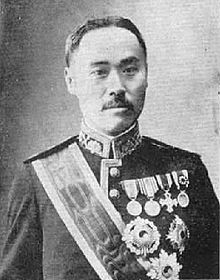 Ye Wanyong
Ye Wanyong
The Japan-Korea Annexation Treaty, signed by the Empire of Japan and puppet Korean Prime Minister Ye Wanyong, strips Korea of its last vestiges of sovereignty. Sunjong, the second and final Emperor of Korea refuses to sign, but the Japanese takeover of the once independent empire of Korea is complete.
1910Japan marches on Manchuria
After blaming an explosion caused by Japanese forces (who acted without approval) on the Chinese, the Japanese army moves into Manchuria, claiming to defend itself from Chinese aggression.
1931Puppet state created
Japan establishes puppet state of Manchukuo, compromising the occupied area of Manchuria. The Japanese name Henry Puyi, the last Chinese emperor who had abdicated in 1912, as nominal head.
1932
Japan invades China in force
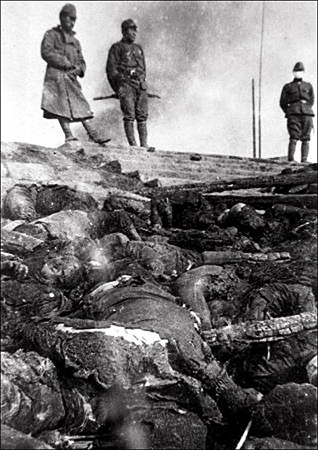 Bodies of Chinese massacred by Japanese troops along a river in Nanking.
Bodies of Chinese massacred by Japanese troops along a river in Nanking.
Japanese launch full-scale invasion of China. By December, the Japanese forces conquer the Chinese Nationalist capital Nanking.
1937French Indochina opens borders
Japan and the pro-German French puppet government on Indochina sign agreement allowing Japanese forces to move troops and supplies through French-ruled Indochina and to occupy the country's northern Tonkin region.
Sept. 22, 1940Indochina occupation begins
Some 140,000 Japanese troops start occupation of French Indochina in preparation of an attack on the Dutch East Indies.
July 27, 1941
Japanese attack Pearl Harbor
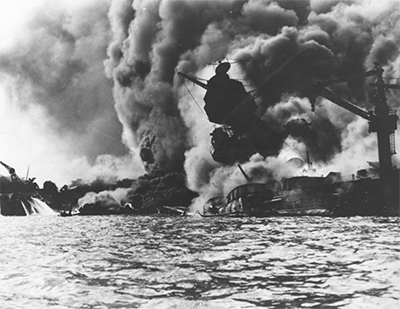 The USS Arizona on fire after the Japanese attack on Pearl Harbor.
The USS Arizona on fire after the Japanese attack on Pearl Harbor.
Dec. 7, 1941
Japan presses attack
Japanese warplanes strike Hong Kong, the Philippines and Singapore. Its army invades southern Thailand and northern Malaya.
Dec. 8, 1941Guam falls
The small U.S. military presence on Guam surrenders to the Japanese.
Dec. 9, 1941Burma invaded
The Japanese-trained Burma Independence Army marches into Burma. Two large Japanese detachments land on the northern coastline of the main Philippine island, Luzon.
Dec.10, 1941Japanese land in British Borneo
The Japanese Empire's Kawaguchi Detachment lands on the coast of British Borneo and swiftly takes control over the island's air fields and oil assets.
Dec. 17, 1941Japan expands island territory
Japan attacks Dutch Borneo, Celebes and the Moluccas in the Dutch East Indies.
Dec. 20, 1941Luzon invaded
Additional Japanese forces land on Luzon, starting the Japanese push toward the Philippines capital Manila.
Dec. 22, 1941
Wake Island falls

Japanese troops capture the American outpost of Wake Island after 11 days of battle.
Above: An American propaganda poster from 1945, bearing an excerpt from the State of the Union address given by President Franklin D. Roosevelt on Jan. 6, 1942.
It reads: "There were only some 400 United States Marines who in the heroic and historic defense of Wake Island inflicted such great losses on the enemy. Some of these men were killed in action and others are now prisoners of war. When the survivors of that great fight are liberated and restored to their homes they will learn that a 130 million of their fellow citizens have been inspired to render their own full share of service-sacrifice."
Hong Kong surrenders to Japan
Japanese forces invaded Hong Kong on Dec. 8, but thanks to stiff fierce resistance from British, Canadian and Indian troops, the city didn't fall until Christmas. More than 10,000 prisoners of war were taken as a result of the Japanese occupation of Hong Kong.
Dec. 25, 1941Manila occupied
Manila falls to the Japanese. U.S. forces retreat to the Bataan Peninsula.
Dec. 27, 1941Bataan under attack
Japanese forces begin main assault on U.S. forces on the Bataan Peninsula.
Jan. 9, 1942Thailand joins the fray
Japan-allied Thailand declares war on the United States and Great Britain.
Jan. 25, 1942
The British surrender Singapore to Japan
 Arthur Percival marches under a flag of truce in order to sue for surrender of the British forces to the Japanese on Feb. 15, 1942.
Arthur Percival marches under a flag of truce in order to sue for surrender of the British forces to the Japanese on Feb. 15, 1942.
British Lt. Gen. Arthur E. Percival surrendered Singapore, handing approximately 16,000 British, 14,000 Australian and 32,000 Indian soldiers to Japanese forces. British Prime Minister Winston Churchill called the surrender "the worst disaster and largest capitulation in British history."
Feb. 15, 1942Java invaded
Japanese invade Java in the Dutch East Indies.
Feb. 28, 1942Japan's territory grows
Japanese forces land in New Guinea at Lae and Salamaua. Allied forces on Java surrender. Bali, Timor and Java fall into Japanese hands, completing the Empire's occupation of the Dutch East Indies.
March 8, 1942
US forces outgunned
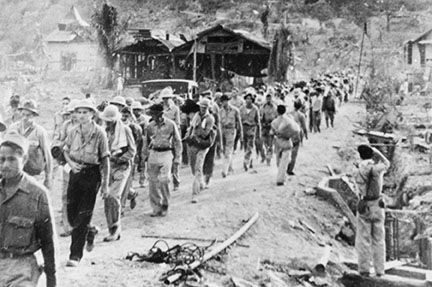 Prisoners of war on the Bataan Death March
Prisoners of war on the Bataan Death March
U.S. forces on the Philippine Bataan Peninsula surrender to the Japanese after three months of fighting. The infamous Bataan Death March - in which thousands of prisoners of war were made to march 65 miles in the grueling jungle heat in just five days - was a result. Thousands died during the march, from dehydration, exhaustion or by execution from the Japanese.
April 9, 1942Corregidor falls
Japan takes Corregidor Island and with it the strategically important access to Manila Bay.
May 6, 1942Burma falls
British troops withdraw completely out of Burma, leaving it to the Japanese.
May 20, 1942Japan marches on Port Moresby
Japanese forces land on the northern coast of New Guinea and start making their way to Port Moresby, the capital, defended by Australian Allied forces.
June 22, 1942
Battle for Guadalcanal begins
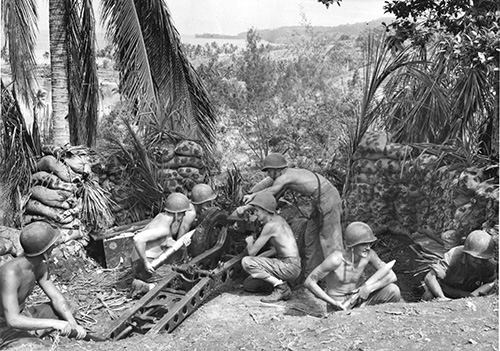 This Marine photo from Oct. 1942 shows Marines in a Japanese-built fighting hole during.
This Marine photo from Oct. 1942 shows Marines in a Japanese-built fighting hole during.
U.S. forces land on Guadalcanal and several other Japanese-held islands in the Solomon Islands chain in an attempt to stop the Japanese advance toward Australia.
Aug. 7, 1942Japan driven out of New Guinea
U.S. and Australian forces defeat the last of the Japanese on New Guinea.
Jan. 2, 1943
Guadalcanal liberated
After six months of fighting, the U.S. gains control of Guadalcanal.
Feb. 9, 1943Burma declared independent by Japan; Indochina occupation begins
Though technically given their independence by Japan, Burma remained firmly under the rule of Japanese troops until the end of the war.
Aug. 1, 1943Philippines declared independent by Japan
Much as with Burma, this independence was a sham. Japan installed the Second Philippine Republic, a puppet government whose main purpose was to incite support of the war on the side of the Axis.
Oct. 14, 1943Allies take Kwajalein
Allied forces take control of Kwajalein Atoll, part of the Marshall Islands.
Feb. 6, 1944Japan invades India
Japanese troops enter India from Burma and move toward Imphal, meeting British and Indian resistance.
March 22, 1944
American troops land on Saipan
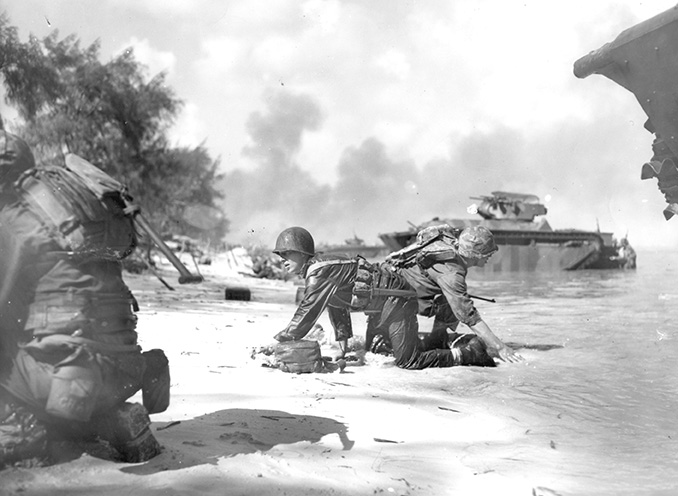 2nd Marine Division troops crawl through enemy fire shortly after hitting the beaches of Saipan.
2nd Marine Division troops crawl through enemy fire shortly after hitting the beaches of Saipan.
U.S. forces land on Saipan, marking the start of the campaign to retake the Marianas Islands.
June 15, 1944Allies land on Guam
U.S. forces land on Guam, the largest of the Marianas Islands.
July 21, 1944
Japanese resistance on Guam ends
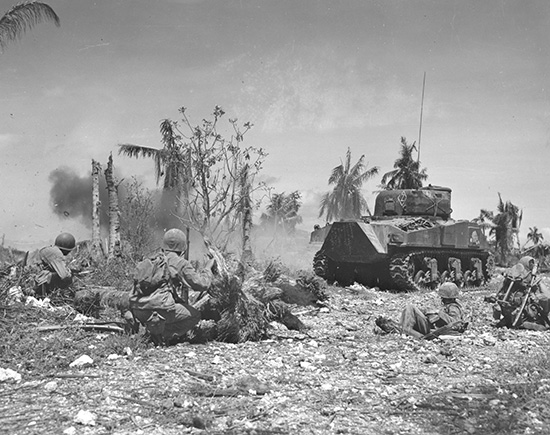 Marines blast Japanese pillboxes as they crouch for cover as they battle for control of Guam.
Marines blast Japanese pillboxes as they crouch for cover as they battle for control of Guam.
Aug. 10, 1944
Japanese forces retreat from India
The twin battles of Imphal and Kohima months earlier broke the Japanese, forcing a humiliating retreat from India.
Aug. 11, 1944Philippine campaign begins
U.S. lands four divisions on Leyte, marking the beginning of the 10-month campaign to retake the Philippines.
Oct. 20, 1944
Allies take Leyte
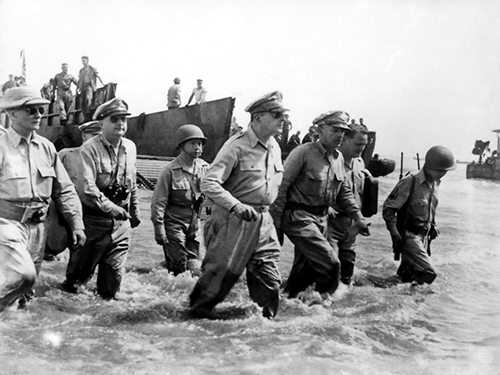 Gen. Douglas MacArthur wades ashore during initial landings at Leyte, Philippine Islands.
Gen. Douglas MacArthur wades ashore during initial landings at Leyte, Philippine Islands.
U.S. forces secure Leyte and direct their efforts to the taking of the largest of the Philippine islands, Luzon.
Dec. 25, 1944U.S. forces land at Luzon
Gen. Douglas MacArthur and the 6th Army land on the Gulf of Luzon, carving an important foothold for the Allies to take the Philippines.
Jan. 9, 1945
U.S. forces land on Iwo Jima
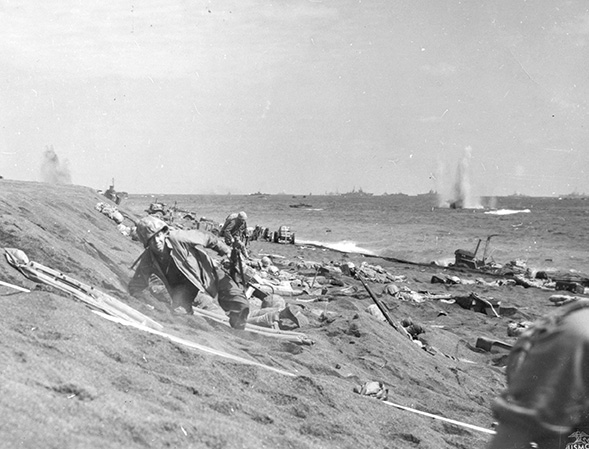 Marines crawl along the beach, digging in to avoid enemy fire as they land on Iwo Jima.
Marines crawl along the beach, digging in to avoid enemy fire as they land on Iwo Jima.
The battle for Iwo Jima began with days of aerial and naval bombardment, after which a massive land invasion began.
Feb. 19, 1945Manila taken by U.S. troops
U.S. forces take Manila, 173 days after landing in Luzon.
March 4, 1945Japan takes Indochina
Japanese take full control of Indochina after the fall of the French pro-German government in France.
March 9, 1945
US forces secure Iwo Jima
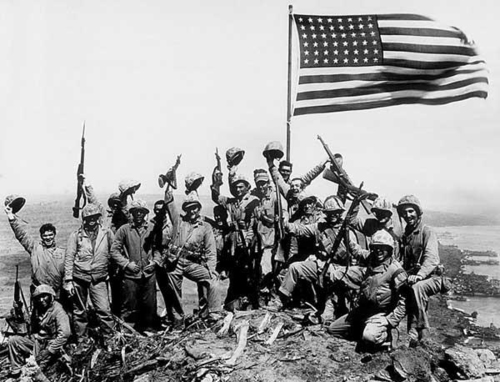 Marines atop Mount Suribachi celebrate raising the American flag.
Marines atop Mount Suribachi celebrate raising the American flag.
After 36 days, the Allies secure Iwo Jima, marking the beginning of the end of the Japanese Empire in the Pacific. More than 26,000 American casualties were recorded, but nearly 20,000 Japanese soldiers were killed attempting to defend the island.
March 16, 1945British forces capture Mandalay, Burma.
After a prolonged siege by the 19th Indian Division, the Japanese evacuated Fort Dufferin in the middle of the night, handing control of Mandalay to the British.
March 20, 1945Battle of Okinawa begins
U.S. forces attack the island of Okinawa.
April 1, 1945
US drops atomic bomb on Hiroshima.
 The mushroom cloud from the atomic bomb dropped over Hiroshima.
The mushroom cloud from the atomic bomb dropped over Hiroshima.
Aug. 6, 1945
Soviets against Japan
Soviet Union declares war on Japan and pours more than one million soldiers into Manchuria, where Japan still has a 700,000-strong army.
April 8, 1945
US drops atomic bomb on Nagasaki.
 The atomic mushroom cloud over Nagasaki.
The atomic mushroom cloud over Nagasaki.
Aug. 9, 1945

Japan announces its unconditional surrender
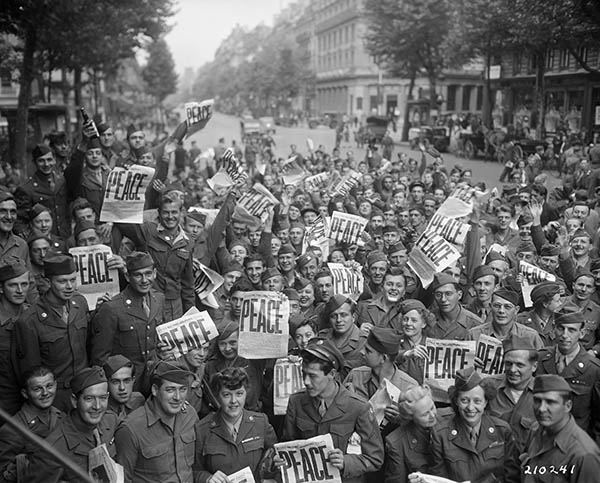 Allied troops in Paris celebrate Victory in Japan Day.
Allied troops in Paris celebrate Victory in Japan Day.
The bloodiest war of the 20th century comes to an end as Japan surrenders unconditionally. More than 55 million people lost their lives as a result of World War II.
Aug. 14, 1945Surrender signed
Japanese sign surrender documents aboard the USS Missouri in Tokyo Bay.
Sept. 2, 1945Troops surrender in China
Japanese authorities in China sign surrender documents.
Sept. 9, 1945Japan surrenders to Britain
Japanese forces within the Southeast Asia Command formally surrender to the British.
Sept. 12, 1945